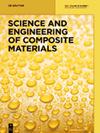跨度长度对聚合物基体中碳纤维织物增强复合材料层压板弯曲性能的影响
IF 1.6
4区 材料科学
Q3 Materials Science
引用次数: 1
摘要
摘要本文主要研究了平纹碳纤维增强聚合物复合层压板(CL)的弯曲响应。本研究的目的是探讨跨度长度与试件厚度比对所选混凝土抗弯性能的影响。叠层试件在跨长与试件厚度比分别为16、20、32、40和60的三点弯曲配置下进行了试验。进行了调查,以确定CL的轴上和45°离轴弯曲响应。为此,制备了两种类型的矩形扁平试件,其配筋方向相对于支撑跨度不同。使用特殊代码,将试件铺层分别指定为[(0/90)F]8和[±45 F]8。结果表明,试件的抗弯模量和抗弯强度与跨长厚比有关。尽管试验的桥身相同,但试件对跨长变化的响应不同。此外,跨度长度对层压试件的最终破坏也有显著影响。本文章由计算机程序翻译,如有差异,请以英文原文为准。
Span length effect on flexural properties of composite laminate reinforced with a plain weave carbon fiber fabric in a polymer matrix
Abstract This article focuses on an experimental study of the flexural response of a polymer composite laminate (CL) reinforced with a plain weave carbon fiber fabric. The aim of this research is to investigate the effect of the span length-to-specimen thickness ratio on the flexural properties of the selected CL. The laminate specimens were tested in the three-point flexure configuration for span length-to-specimen thickness ratios of 16, 20, 32, 40 and 60. The investigations were carried out to identify on-axis and 45° off-axis flexural responses of the CL. For this reason, two types of rectangular flat specimens were prepared, differing in reinforcement orientation relative to the support span. Using the special code, the lay-up of the specimens was designated as [(0/90)F]8 and [±45 F]8, respectively. It was found that the flexural modulus and flexural strength of the specimens depend on the span length-to-specimen thickness ratio. Despite testing the same CL, the response of the specimens to the change in the span length is different. In addition, it was concluded that the span length also has a significant influence on the final failure of the laminate specimens.
求助全文
通过发布文献求助,成功后即可免费获取论文全文。
去求助
来源期刊

Science and Engineering of Composite Materials
工程技术-材料科学:复合
CiteScore
3.10
自引率
5.30%
发文量
0
审稿时长
4 months
期刊介绍:
Science and Engineering of Composite Materials is a quarterly publication which provides a forum for discussion of all aspects related to the structure and performance under simulated and actual service conditions of composites. The publication covers a variety of subjects, such as macro and micro and nano structure of materials, their mechanics and nanomechanics, the interphase, physical and chemical aging, fatigue, environmental interactions, and process modeling. The interdisciplinary character of the subject as well as the possible development and use of composites for novel and specific applications receives special attention.
 求助内容:
求助内容: 应助结果提醒方式:
应助结果提醒方式:


